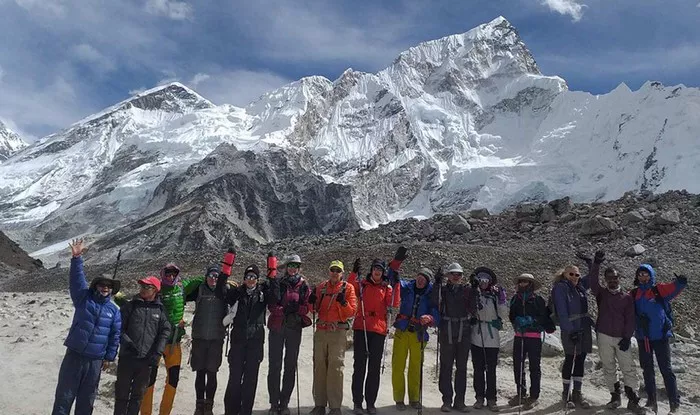Embarking on the journey to Everest Base Camp is a dream for many adventurers, offering a thrilling mix of stunning landscapes, rich cultural experiences, and the ultimate test of physical endurance. But for those contemplating this iconic trek, one of the most pressing questions is: How long does it take to trek to Everest Base Camp? In this comprehensive guide, we delve into the intricacies of the journey, exploring the full distance, difficulty level, and factors that influence the duration of this epic adventure.
Understanding the Distance:
The Everest Base Camp trek covers approximately 130 kilometers (80 miles) round trip from the starting point in Lukla to the base camp itself and back. This distance is spread across multiple days, allowing trekkers to acclimatize to the high altitude and immerse themselves in the awe-inspiring Himalayan scenery. While the total distance may seem manageable, it’s essential to remember that the rugged terrain, high altitude, and variable weather conditions can significantly impact the pace of the journey.
Factors Influencing Trek Duration:
Several factors come into play when determining the duration of an Everest Base Camp trek:
1. Itinerary Choice:
The duration of the trek largely depends on the chosen itinerary. Standard itineraries typically range from 12 to 16 days, allowing for gradual acclimatization and ample rest days. However, some expedited itineraries can complete the trek in as little as 9 to 10 days, albeit with a more demanding pace and higher risk of altitude-related issues.
2. Acclimatization Needs:
Acclimatization is crucial when trekking to high altitudes to minimize the risk of altitude sickness. Longer itineraries often include additional rest days at strategic points along the route, such as Namche Bazaar and Dingboche, allowing trekkers to adjust to the thinner air gradually.
3. Fitness Level:
The fitness level of the trekker plays a significant role in determining the pace and duration of the trek. While the Everest Base Camp trek does not require mountaineering skills, it involves long hours of hiking over varied terrain, including steep ascents and descents. Trekkers with higher fitness levels may cover the distance more quickly, whereas those less accustomed to physical exertion may prefer a more leisurely pace.
4. Weather Conditions:
The weather in the Everest region can be unpredictable, with conditions ranging from clear skies to snowstorms, especially during the peak trekking seasons in spring and autumn. Adverse weather can delay or even halt progress along the trail, necessitating flexibility in the trekking schedule.
5. Altitude Challenges:
As trekkers ascend to higher elevations, the thin air can significantly impact their pace and energy levels. Symptoms of altitude sickness, such as headaches, nausea, and fatigue, may slow progress and necessitate rest breaks or even descent to lower altitudes for recovery.
Typical Trek Duration:
While the duration of an Everest Base Camp trek can vary depending on the factors mentioned above, a standard itinerary typically spans between 12 to 16 days. Below is a breakdown of a typical 14-day itinerary, which allows for adequate acclimatization and rest days:
Day 1-2: Kathmandu to Lukla and Phakding
The journey begins with a scenic flight from Kathmandu to Lukla, followed by a trek to Phakding, a picturesque village along the Dudh Koshi River.
Day 3-4: Namche Bazaar
Trekking from Phakding to Namche Bazaar, the bustling Sherpa capital, involves a challenging ascent. Rest day in Namche allows for acclimatization and exploration of the surrounding area.
Day 5-7: Tengboche to Dingboche
Continuing the trek through rhododendron forests and across suspension bridges, trekkers reach Tengboche with its famous monastery. The journey then progresses to Dingboche, with another rest day for acclimatization.
Day 8-9: Lobuche to Gorak Shep and Everest Base Camp
Trekking from Lobuche to Gorak Shep, trekkers embark on the final push to Everest Base Camp, a momentous achievement. Return to Gorak Shep for overnight stay.
Day 10-12: Descent and Return
Descending from Gorak Shep to Namche Bazaar and onwards to Lukla, trekkers retrace their steps through familiar terrain, culminating in a celebratory evening in Lukla before the flight back to Kathmandu.
Conclusion:
The duration of an Everest Base Camp trek varies depending on multiple factors, including itinerary choice, acclimatization needs, fitness level, weather conditions, and altitude challenges. While standard itineraries typically span between 12 to 16 days, trekkers should prioritize safety, acclimatization, and enjoyment of the journey over completing the trek within a specific timeframe. With proper preparation, determination, and respect for the challenges of the Himalayas, the journey to Everest Base Camp promises an unforgettable adventure of a lifetime.

